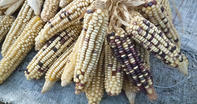
Regularly eating a variety of fruit and vegetables ensures a healthy intake of a variety of nutrients. Nutrients are needed to maintain healthy bodies and strong minds as well as helping children grow and develop well.
To remain healthy it is recommended to regularly eat from the following seven food groups: starchy foods, fresh vegetables and fruits, dry beans (or peas, lentils or soya), meat (red meat, chicken, fish, or eggs), dairy (milk, maas, yoghurt), fats and water.
By including indigenous crops to provide the nutrients in the various food groups your diet can be improved. For example, cowpeas are high in protein and iron (and can serve as a meat substitute), while the red milkwood fruit is very high in vitamin C. Most importantly, these crops can be grown in small gardens, plots and also grow wild in nature.
On a national scale South Africa produces enough food, in fact, the country is also a net exporter of most food crops. Despite this, 14 million people in South Africa are said to be food insecure. (‘Food secure’ means having enough safe and nutritious food). The South African food system is based on only a few crops and there is an over-reliance on maize. There is also a decline in household food production and a negative perception that indigenous food crops are only for poor people.
South Africa has the third largest biodiversity in the world. These natural assets are located throughout South Africa and are often abundant in rural areas. In rural areas, indigenous foods can form an integral part of rural livelihoods. Communities can depend on indigenous foods to compliment their diets and help them to survive through times of hardship.
‘Hidden Hunger’ in South Africa
While there is not much evidence of wide-scale starvation in South Africa, national surveys found widespread ‘hidden hunger’ (a lack of nutrients) and increasing rates of adult obesity and child stunting (retarded growth).A study in the poorest areas in four South African provinces was conducted in 2013 - 2015, by the Water Research Commission (WRC) and the University of Pretoria, to determine how crop production contributes to food security.
The study revealed that most households were able to buy maize meal and where income was sufficient, this maize meal diet was supplemented with a relish of onion and tomato or cabbage.
The study’s conclusion was that the diets lacked the diversity that is needed to ensure proper productivity and child development. It also found a link between the growing of crops and improved quality of a household’s diet. In addition, the income from farming and irrigated crop production increased the consumption of meat, eggs, fruit and vegetables.
The study also identified which crops can improve nutrition. Dark green leafy vegetables such as spinach, beetroot leaves, nettle, nightshade, amaranth and blackjack are recommended as well as vegetables like squash (‘calabash’), green pepper, lettuce, pumpkin, tomatoes and baby marrows.
Fruit also increases nutrients in the diet and those that can be grown in South Africa include; mango, papaya, avocado, marula and watermelon. Roots such as amadumbe and sweet potato are also recommended along with legumes, which include Bambara groundnut, cowpeas and peanuts.
Waterwise indigenous food crops - crops that do not need a lot of water - include amadumbe, sweet potato, squash, African leafy vegetables, cowpeas, eggplant, green pepper, onion, watermelon, figs, loquat, and all legumes.
Other recommendations of this study include:
Grow nutrient-dense crops such as beetroot.
Harvest rainwater or install irrigation to water crops.
Pipelines and boreholes may be needed in dry areas.
Biofortification of nutrient-dense crops is needed, especially in dual-purpose crops such as beetroot.
By Marinda Louw